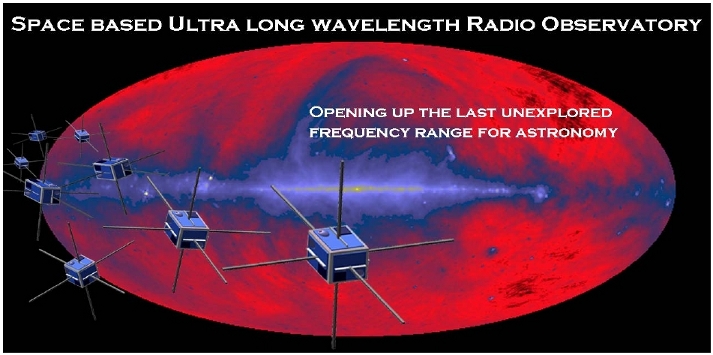Daily Image
07-07-2010Space Based Ultra Long Wavelength Radio Observatory (SURO)
| Submitter: | Albert-Jan Boonstra |
| Description: | In 2007 and 2008, ESA commissioned two independent studies on a novel passive formation-flying satellite concept, DARIS (PI ASTRON) and FIRST (PI Psi-tran). These studies have now been brought together for a review by the scientific community of the science benefits and impact. For the ESA Cosmic Vision program 2015-2025, we aim to propose a space based low-frequency radio array (SURO). SURO will operate in the virtually unexplored frequency domain below 30 MHz (wavelength > 10 m), which is difficult to access from Earth due to ionospheric effects and man-made interference. Initially, SURO will be a 5-8 satellite aperture synthesis array in passive formation flight, but it will be scalable. The astronomical science case includes sensitive high resolution (~0.6') extra-galactic surveys, detection of radio transients such as Jupiter-like flares and Crab-like pulses, radio imaging of the Sun. Scaling up the array, in free space or on the far-side of the Moon, would open up an even larger scientific domain. Technical specifications of SURO: baselines up to 100 km yielding resolutions down to 0.6 arcmin, full Stokes polarimetry, nominal frequency range of 1-30 MHz with a 10% relative bandwidth, and sensitivity < 65 mJy, depending on the number of satellites and observing time. The latter is sufficient for confusion-limited operation. The astronomical and space science objectives of SURO will be achieved with proven technologies, which do not require extensive further research. The array elements will be deployed from a mothership, which acts both as a correlator and as a relay station to Earth. At the 10-14 June Science Meeting “A New Golden Age for Radio Astronomy” the science cases for the SURO mission was presented together with a brief overview of the proposed satellite concept. Sky map - courtesy Haslam et al, A&A 1982; satellite images - courtesy DARIS project |
| Copyright: | DARIS/FIRST |
| Tweet |  |
